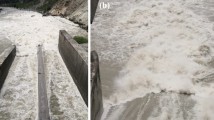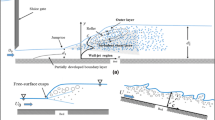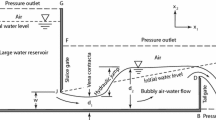Abstract
A hydraulic jump is the rapid transition from a supercritical to subcritical free-surface flow. It is characterised by strong turbulence and air bubble entrainment. New air–water flow properties were measured in hydraulic jumps with partially developed inflow conditions. The data set together with the earlier data of Chanson (Air bubble entrainment in hydraulic jumps. Similitude and scale effects, 119 p, 2006) yielded similar experiments conducted with identical inflow Froude numbers Fr 1 = 5 and 8.5, but Reynolds numbers between 24,000 and 98,000. The comparative results showed some drastic scale effects in the smaller hydraulic jumps in terms of void fraction, bubble count rate and bubble chord time distributions. The present comparative analysis demonstrated quantitatively that dynamic similarity of two-phase flows in hydraulic jumps cannot be achieved with a Froude similitude. In experimental facilities with Reynolds numbers up to 105, some viscous scale effects were observed in terms of the rate of entrained air and air–water interfacial area.






Similar content being viewed by others
Abbreviations
- C :
-
void fraction defined as the volume of air per unit volume of air
- C max :
-
maximum void fraction in the air bubble diffusion layer
- D t :
-
turbulent diffusivity (m2/s) of air bubbles in air–water flow
- D* :
-
dimensionless turbulent diffusivity: \( D^{*} = \frac{{D_{t} }} {{V_{1} d_{1} }} \)
- d ab :
-
bubble size (m)
- d 1 :
-
upstream flow depth (m)
- F :
-
bubble count rate (Hz), or bubble frequency (number of detected air bubbles per unit time)
- F max :
-
maximum bubble count rate (Hz) at a given cross-section
- Fr 1 :
-
upstream Froude number: \( Fr_{1} = V_{1} /{\sqrt {gd_{1} } } \)
- g :
-
gravity constant: g = 9.80 m/s2 in Brisbane, Australia
- L scale :
-
geometric scaling ratio defined as the ratio of prototype to model dimensions
- Mo :
-
Morton number defined as: Mo = g μ4/(ρ σ3)
- N ab :
-
number of air bubbles per record
- Q :
-
water discharge (m3/s)
- q :
-
water discharge per unit width (m2/s)
- Re :
-
Reynolds number: Re = ρV 1 d 1/μ
- u′:
-
root mean square of longitudinal component of turbulent velocity (m/s)
- V :
-
interfacial velocity (m/s)
- W :
-
channel width (m)
- We :
-
Weber number
- x :
-
longitudinal distance from the upstream gate (m)
- x 1 :
-
longitudinal distance from the gate to the jump toe (m)
- y :
-
distance (m) measured normal to the channel bed
- \( Y_{{C_{{\max }} }} \) :
-
distance (m) normal to the jet support where C = C max
- z :
-
transverse distance (m) from the channel centreline
- δ:
-
boundary layer thickness (m)
- μ:
-
dynamic viscosity of water (Pa s)
- ρ:
-
density (kg/m3) of water
- σ:
-
surface tension between air and water (N/m)
- ∅:
-
diameter (m)
- 1:
-
upstream flow conditions
References
Bélanger JB (1828) Essai sur la Solution Numérique de quelques Problèmes Relatifs au Mouvement Permanent des Eaux Courantes. Carilian-Goeury, Paris, France (in French)
Chanson H (1995) Air entrainment in two-dimensional turbulent shear flows with partially developed inflow conditions. Int J Multiphase Flow 21(6):1107–1121
Chanson H (1997) Air bubble entrainment in free-surface turbulent shear flows. Academic Press, London, 401 p
Chanson H (2002) Air–water flow measurements with intrusive phase-detection probes. Can we improve their interpretation?. J Hydraulic Eng Trans ASCE 128(3):252–255
Chanson H (2006) Air bubble entrainment in hydraulic jumps. Similitude and scale effects. Report No. CH57/05, Department of Civil Engineering, The University of Queensland, Brisbane, 119 p
Chanson H (2007a) Bubbly flow structure in hydraulic jump. Euro J Mech B/Fluids 26(3):367–384
Chanson H (2007b) Dynamic similarity and scale effects affecting air bubble entrainment in hydraulic jumps. In: Sommerfield M (ed) Proceedings 6th international conference on multiphase flow ICMF 2007, Leipzig, Germany, July 9–13, Session 7, Paper S7_Mon_B_S7_Mon_B_3, 11 pages (CD-ROM)
Chanson H, Brattberg T (2000) Experimental study of the air–water shear flow in a hydraulic jump. Int J Multiphase Flow 26(4):583–607
Chanson H, Carosi G (2007a) Turbulent time and length scale measurements in high-velocity open channel flows. Exp Fluids 42(3):385–401. doi:10.1007/s00348-006-0246-2
Chanson H, Carosi G (2007b) Advanced post-processing and correlation analyses in high-velocity air–water flows. Environ Fluid Mech 7(6):495–508. doi:10.1007/s10652-007-9038-3
Chanson H, Gualtieri C (2008) Similitude and scale effects of air entrainment in hydraulic jumps. J Hyd Res IAHR 46(1):35–44
Crowe C, Sommerfield M, Tsuji Y (1998) Multiphase flows with droplets and particles. CRC Press, Boca Raton, 471 p
Henderson FM (1966) Open channel flow. MacMillan Company, New York
Mossa M, Tolve U (1998) Flow visualization in bubbly two phase hydraulic jumps. J Fluids Eng Trans ASME 120:160–165
Murzyn F, Chanson H (2007) Free surface, bubbly flow and turbulence measurements in hydraulic jumps. Report No. CH63/07, Division of Civil Engineering, The University of Queensland, Brisbane, July, 116 p
Murzyn F, Mouazé D, Chaplin JR (2005) Optical fibre probe measurements of bubbly flow in hydraulic jumps. Int J Multiphase Flow 31(1):141–154
Murzyn F, Mouazé D, Chaplin JR (2007) Air–water interface dynamic and free surface features in hydraulic jumps. J Hydraulic Res IAHR 45(5):679–685
Rajaratnam N (1962) An experimental study of air entrainment characteristics of the hydraulic jump. J Inst Eng India 42(7):247–273
Resch FJ, Leutheusser HJ (1972) Le Ressaut Hydraulique: mesure de Turbulence dans la Région Diphasique. La Houille Blanche No. 4, pp 279–293 (in French)
Toombes L (2002) Experimental study of air–water flow properties on low-gradient stepped cascades. In: PhD thesis, Department of Civil Engineering, The University of Queensland, Brisbane
Wood IR (1991) Air entrainment in free-surface flows. IAHR hydraulic structures design manual no. 4, hydraulic design considerations, Balkema Publ., Rotterdam, 149 p
Acknowledgments
The writers acknowledge the technical assistance of Graham Illidge and Clive Booth. The first writer acknowledges the financial support of the ESTACA and particularly François Stephan (Head of Department).
Author information
Authors and Affiliations
Corresponding author
Rights and permissions
About this article
Cite this article
Murzyn, F., Chanson, H. Experimental assessment of scale effects affecting two-phase flow properties in hydraulic jumps. Exp Fluids 45, 513–521 (2008). https://doi.org/10.1007/s00348-008-0494-4
Received:
Revised:
Accepted:
Published:
Issue Date:
DOI: https://doi.org/10.1007/s00348-008-0494-4




